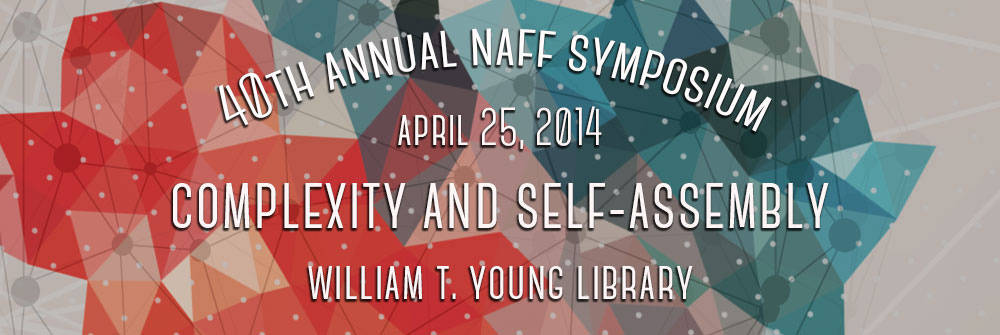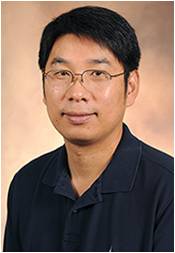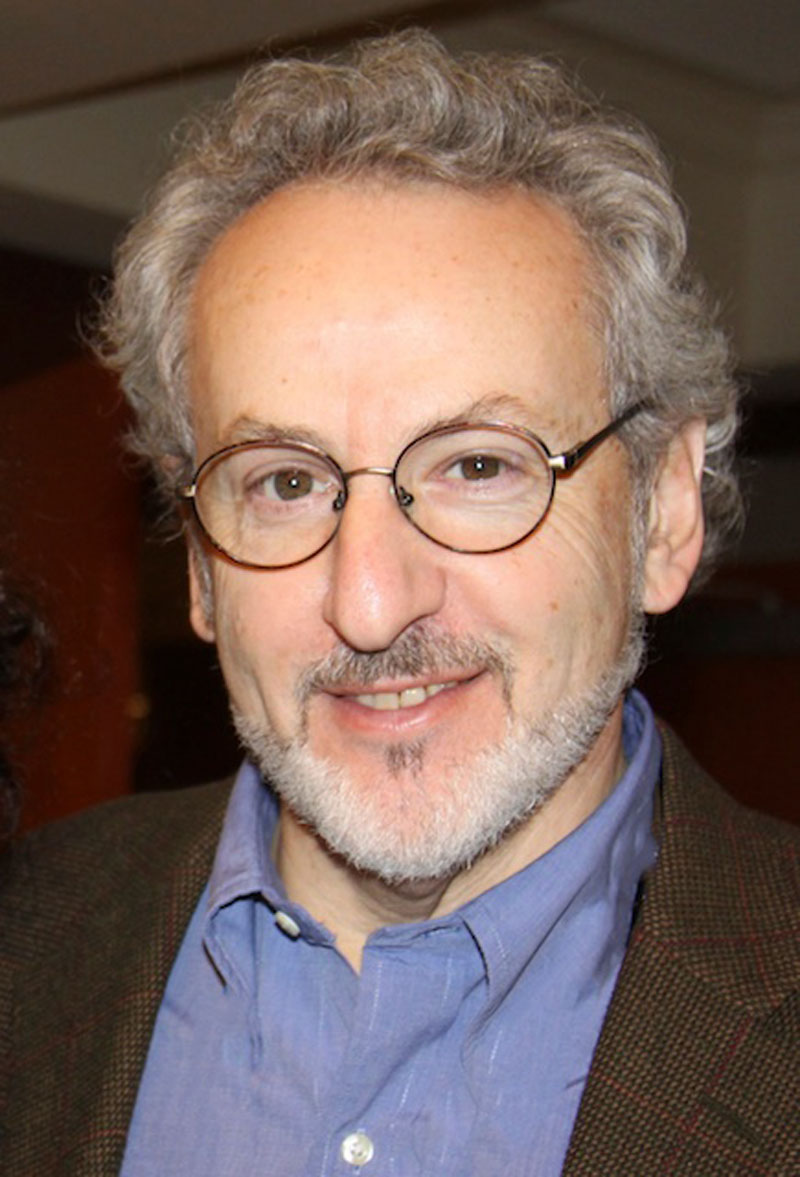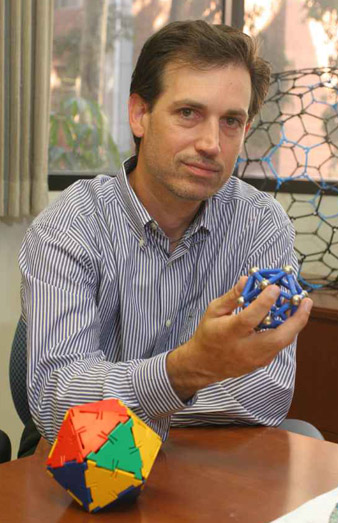
Schedule of Events |
|
|---|---|
| 8:00 a.m. | Registration & Continental Breakfast Gallery, W.T. Young Library |
| 8:45 a.m. | Welcome Dr. Eli Capilouto, University of Kentucky President Auditorium, W.T. Young Library |
| 9:00 a.m. | Dr. Hao Yan Designer Architectures for Programmable Self-assembly Auditorium, W.T. Young Library |
| 10:00 a.m. | Break (refreshments available) Gallery, W.T. Young Library |
| 10:30 a.m. | Dr. Donald Ingber From Cellular Mechanotransduction to Biologically Inspired Engineering Auditorium, W.T. Young Library |
| 11:30 a.m. | Lunch |
| 1:30 p.m. | Poster Session - To view abstracts, click here. King Alumni House Ballroom |
| 2:30 p.m. | Dr. Todd Yeates Giant Protein Cages and Assemblies in Nature and by Design Auditorium, W.T. Young Library |
Abstracts & Bios |
|---|
|
Designer Architectures for Programmable Self-assembly Abstract: The central task of nanotechnology is to control motions and organize matter with nanometer precision. To achieve this, scientists have investigated a large variety of materials including inorganic materials, organic molecules, and biological polymers as well as different methods that can be sorted into so-called “bottom-up” and “top-down” approaches. Among all of the remarkable achievements made, the success of DNA self-assembly in building programmable nanopatterns has attracted broad attention. In this talk I will present our efforts in using DNA as an information-coding polymer to program and construct DNA nano-architectures with complex geometrical features. Use of designer DNA architectures as molecular sensor, actuator and scaffolds will also be discussed. |
|
From Cellular Mechanotransduction to Biologically Inspired Engineering Abstract: The newly emerging field of Biologically Inspired Engineering centers on understanding the fundamental principles that Nature uses to build and control living systems, and on applying this knowledge to engineer biologically inspired materials and devices for medicine, industry and the environment. A central challenge in this field is to understand of how living cells and tissues are constructed so that they exhibit their incredible organic properties, including their ability to change shape, move, grow, and self-heal. These are properties we strive to mimic, but we cannot yet build manmade devices that exhibit or selectively control these behaviors. To accomplish this, we must uncover the underlying design principles that govern how cells and tissues form and function as hierarchical assemblies of nanometer scale components. In this lecture, I will review work that has begun to reveal these design principles that guide self-assembly of living 3D structures with great robustness, mechanical strength and biochemical efficiency, even though they are composed of many thousands of flexible molecular scale components. Key to this process is that the molecular frameworks of our cells, tissues and organs are stabilized using a tension-dependent architectural system, known as ‘tensegrity’, and these tensed molecular scaffolds combine mechanical load-bearing functions with solid-phase biochemical processing activities. I will describe how this structural perspective has led to new insights into the molecular basis of cellular mechanotransduction – the process by which living cells sense mechanical forces and convert them into changes in intracellular biochemistry, gene expression and thereby influence cell fate decisions during tissue and organ development. In addition, I will present how these scientific advances have been facilitated by development of new micro- and nano-technologies, including engineering of novel human organ-on-a-chip microdevices that also have great potential value as replacements for animal testing in drug development and discovery research. Understanding of these design principles that govern biological organization, and how scientific discovery and technology development can be facilitated by equally melding fundamental science and applied engineering, are critical for anyone who wants to fully harness the power of biology. Bio: Donald E. Ingber, MD, PhD is the Founding Director of the Wyss Institute for Biologically Inspired Engineering at Harvard University, the Judah Folkman Professor of Vascular Biology at Harvard Medical School and Boston Children's Hospital, and Professor of Bioengineering at the Harvard Sch |
|
Giant Protein Cages and Assemblies in Nature and by Design Abstract: Nature has evolved myriad sophisticated structures based on the assembly of protein subunits. Many types of natural protein assemblies (such as virus capsids) have been studied extensively, while a number of equally sophisticated natural protein assemblies are only beginning to be appreciated. Among the latter group is a broad class of giant, capsid-like assemblies referred to as bacterial microcompartments. They serve as primitive metabolic organelles in many bacteria by encapsulating sequentially acting enzymes within a selectively permeable protein shell. Our laboratory has elucidated key mechanisms of these protein-based bacterial organelles through structural studies. On the engineering side, sophisticated natural protein assemblies like these have for many years represented an ultimate goal in protein design. By exploiting principles of symmetry that are shared by nearly all natural self-assembling structures, we have developed methods for engineering novel proteins that assemble to form a variety of complex, symmetric architectures. Recent successful designs include hollow protein cages composed of 12 or 24 identical subunits in cubic arrangements. Symmetric materials that extend by growth in two or three dimensions are also possible. Natural and engineered protein assemblies will be discussed, along with their future prospects for synthetic biology and biomedical applications.
|
2014 Naff Committee Members:
Professor Jason DeRouchey (Chair, Chemistry)
Professor Marcelo Guzman (Chemistry)
Professor Chris Richards (Chemistry)
Professor Anne-Francis Miller (Chemistry)
Professor Stephen Testa (Chemistry)
For more information, contact Dr. Jason DeRouchey.


 ool of Engineering and Applied Sciences. He received his B.A., M.A., M.Phil., M.D. and Ph.D. from Yale University. Dr. Ingber is a founder of the emerging field of biologically inspired engineering, and at the Wyss Institute, he oversees a multifaceted effort to identify the mechanisms that living organisms use to self-assemble from molecules and cells, and to apply these design principles to develop advanced materials and devices for healthcare and to improve sustainability. He also leads the Biomimetic Microsystems platform in which microfabrication techniques from the computer industry are used to build functional circuits with living cells as components. His most recent innovation is a technology for building tiny, complex, three-dimensional models of living human organs, or "Organs on Chips", that mimic complicated human functions as a way to replace traditional animal-based methods for testing of drugs and establishment of human disease models. In addition, Dr. Ingber has made major contributions to mechanobiology, tissue engineering, tumor angiogenesis, systems biology, and nanobiotechnology. He was the first to recognize that tensegrity architecture is a fundamental principle that governs how living cells self-organize themselves to respond biochemically to mechanical forces, and to demonstrate that integrin receptors mediate cellular mechanotransduction. Dr. Ingber has authored more than 375 publications and 85 patents, and has received numerous honors including the Holst Medal, Pritzker Award from the Biomedical Engineering Society, Rous-Whipple Award from the American Society for Investigative Pathology, Lifetime Achievement Award from the Society of In Vitro Biology, and the Department of Defense Breast Cancer Innovator Award. He also serves on the Board of Directors of the National Space Biomedical Research Institute, and is a member of both the American Institute for Medical and Biological Engineering, and the Institute of Medicine of the National Academies.
ool of Engineering and Applied Sciences. He received his B.A., M.A., M.Phil., M.D. and Ph.D. from Yale University. Dr. Ingber is a founder of the emerging field of biologically inspired engineering, and at the Wyss Institute, he oversees a multifaceted effort to identify the mechanisms that living organisms use to self-assemble from molecules and cells, and to apply these design principles to develop advanced materials and devices for healthcare and to improve sustainability. He also leads the Biomimetic Microsystems platform in which microfabrication techniques from the computer industry are used to build functional circuits with living cells as components. His most recent innovation is a technology for building tiny, complex, three-dimensional models of living human organs, or "Organs on Chips", that mimic complicated human functions as a way to replace traditional animal-based methods for testing of drugs and establishment of human disease models. In addition, Dr. Ingber has made major contributions to mechanobiology, tissue engineering, tumor angiogenesis, systems biology, and nanobiotechnology. He was the first to recognize that tensegrity architecture is a fundamental principle that governs how living cells self-organize themselves to respond biochemically to mechanical forces, and to demonstrate that integrin receptors mediate cellular mechanotransduction. Dr. Ingber has authored more than 375 publications and 85 patents, and has received numerous honors including the Holst Medal, Pritzker Award from the Biomedical Engineering Society, Rous-Whipple Award from the American Society for Investigative Pathology, Lifetime Achievement Award from the Society of In Vitro Biology, and the Department of Defense Breast Cancer Innovator Award. He also serves on the Board of Directors of the National Space Biomedical Research Institute, and is a member of both the American Institute for Medical and Biological Engineering, and the Institute of Medicine of the National Academies. Bio: Todd Yeates earned his Bachelor's degree at UCLA in 1983. He stayed on at UCLA and earned his PhD in 1988 while doing research under the direction of Prof. Douglas Rees. There he helped determine the crystal structure of the bacterial photosynthetic reaction center as part of a team racing to determine the first crystal structures of membrane proteins. He then moved to The Scripps Research Institute to do his postdoctoral research on the structure of poliovirus with Prof. James Hogle. Yeates returned to UCLA in 1990 to join the Faculty in the Department of Chemistry and Biochemistry. His interdisciplinary research, combining molecular biology with computing and mathematics, has focused on macromolecular structure and computational genomics. His varied research findings include: an explanation for why proteins crystallize in certain favored arrangements; the development of new equations for detecting disorder in x-ray diffraction data from protein crystals; the discovery of thermophilic microbes rich in intracellular disulfide bonds; development of comparative genomics methods; development of designed protein cages or 'nanohedra'; the discovery of novel topological features such as links and slipknots that stabilize thermostable proteins; and elucidation of the structure of the carboxysome shell and the shells of other bacterial microcompartments, which serves as primitive metabolic organelles inside many bacterial cells. Yeates is a member of the Molecular Biology Institute, the California Nanosystems Institute, the UCLA-DOE Institute of Genomics and Proteomics, and a Fellow of the American Association for the Advancement of Science. He has published approximately 150 research papers.
Bio: Todd Yeates earned his Bachelor's degree at UCLA in 1983. He stayed on at UCLA and earned his PhD in 1988 while doing research under the direction of Prof. Douglas Rees. There he helped determine the crystal structure of the bacterial photosynthetic reaction center as part of a team racing to determine the first crystal structures of membrane proteins. He then moved to The Scripps Research Institute to do his postdoctoral research on the structure of poliovirus with Prof. James Hogle. Yeates returned to UCLA in 1990 to join the Faculty in the Department of Chemistry and Biochemistry. His interdisciplinary research, combining molecular biology with computing and mathematics, has focused on macromolecular structure and computational genomics. His varied research findings include: an explanation for why proteins crystallize in certain favored arrangements; the development of new equations for detecting disorder in x-ray diffraction data from protein crystals; the discovery of thermophilic microbes rich in intracellular disulfide bonds; development of comparative genomics methods; development of designed protein cages or 'nanohedra'; the discovery of novel topological features such as links and slipknots that stabilize thermostable proteins; and elucidation of the structure of the carboxysome shell and the shells of other bacterial microcompartments, which serves as primitive metabolic organelles inside many bacterial cells. Yeates is a member of the Molecular Biology Institute, the California Nanosystems Institute, the UCLA-DOE Institute of Genomics and Proteomics, and a Fellow of the American Association for the Advancement of Science. He has published approximately 150 research papers.